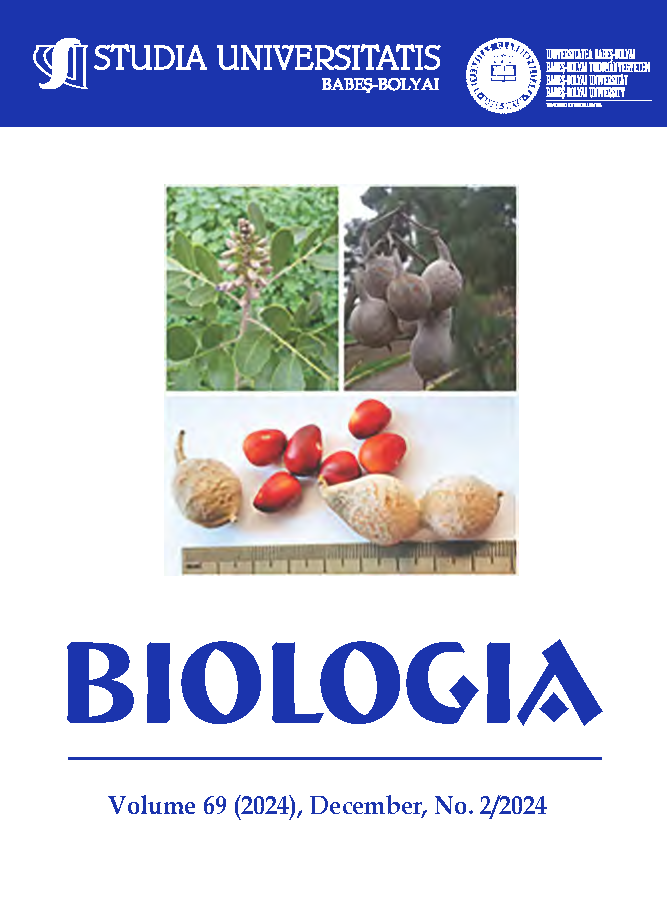Influence of substrate particle size and detention time on mycelium-colonized sawdust efficiency for removal of faecal bacteria from slaughterhouse wastewater in batch treatment
DOI:
https://doi.org/10.24193/subbbiol.2024.2.08Keywords:
batch treatment, colonized, faecal bacteria, mycelium, mycofilterAbstract
Mycofiltration is a recent cost-effective biotechnology that is still under development for wastewater treatment. The use of mycelium-colonised substrate for wastewater treatment in a batch system with delayed residence time and the effect of sawdust particles has not previously been considered. Slaughterhouse wastewater is discharged untreated in many developing countries majorly due to the high cost of existing conventional treatment systems. The effect of sawdust detention time and particle size on the removal efficiency of faecal bacteria from slaughterhouse wastewater by Pleurotus ostreatus mycelium was assessed in the lab using mycelium colonized with sawdust of particle sizes (0.6, 1.18, 2.36 mm and unsorted particle sizes) and under varying detention times (0, 12, 24, 36, 48, 60 and 72 hours) using batch treatment procedure. Hydrogen peroxide produced during mycelium colonisation of the sawdust was also evaluated. Oxidation-reduction potential (ORP) was measured during this study to determine the oxidative capacity in each treatment reactor. The removal efficiency of Escherichia coli ranged from -7.9 – 77.2 % and was the highest for mycofilter with 2.36 mm sawdust particle size at 72 hours detention time (0.7 log removal). Salmonella spp. removal efficiency ranged from 0.66 – 71 % with the highest efficiency recorded in the system with 1.16 mm also at 72 hours (0.4 log removal). Mean hydrogen peroxide concentration ranged from 0.53±0.12 (unsorted inoculated) to 25.18±1.77 mg/l (1.18 mm, 72 hours). ORP values ranged from 5.0 ±2.2 mV (raw wastewater, 24 hours) to 232±55 mV (unsorted inoculated, 72 hours). The result of this study showed that substrate particle size and detention time have roles to play in the efficiency of mycofilters using batch treatment. The concentration of hydrogen peroxide was also influenced significantly by sawdust particle size. Therefore, there is a need to further study this system in a bid to optimize its ability to remove faecal bacteria from wastewater.
Article history: Received 26 October 2023; Revised 13 October 2024;
Accepted 20 November 2024; Available online 10 December 2024
References
APHA (2005). Standard methods for the examination of water and wastewater, 21st ed. American Public Health Association, Washington, DC.
Chen, L., Pinto, A. & Alshawabkeh, A.N. (2019). Activated carbon as a cathode for water disinfection through the electro-fenton process. Catalyst, 9(7). https://doi.org/10.3390/catal9070601
Eichlerová, I., Homolka, L., Lisá, L. & Nerud, F. (2006). The influence of extracellular H2O2 production on decolorization ability in fungi. J. Basic Microb, 46(6), 449–455. https://doi.org/10.1002/jobm.200610064
El Sayed, M.T. & El-Sayed, A.S.A. (2020). Bioremediation and tolerance of zinc ions using Fusarium solani. Heliyon, 6(9). https://doi.org/10.1016/j.heliyon.2020.e05048
George, I., Crop, P. & Servais, P. (2002). Fecal coliform removal in wastewater treatment plants studied by plate counts and enzymatic methods. Water. Res, 36(10), 2607–2617. https://doi.org/10.1016/S0043-1354(01)00475-4
Koivunen, J., Siitonen, A. & Heinonen-Tanski, H. (2003). Removal of heavy metals from wastewater. Water. Res, 37(2003), 690–698.
Lawal, N., Babalola, A.A., Ojo, O.S. & Adegoke, A. (2018). Characterization and treatability assessment of abattoir wastewater using Pennisetum purpureium stalks as filter media: A pilot study . J. Exp. Re, 6(3), 22–27.
Liu, Q., Bai, J. Feng, Gu, W. Hua, Peng, S. Juan, Wang, L. Cai, Wang, J. Wei & Li, H.X. (2020). Leaching of copper from waste printed circuit boards using Phanerochaete chrysosporium fungi. Hydrometallurgy, 196, 105427. https://doi.org/10.1016/j.hydromet.2020.105427
Martinez, S. (2016). E. coli removal by Pleurotus ostreatus mycofilter in simulated wet environmental pond. M.Sc Dissertation submitted to Civil Engineering ETDs. University of New Mexico,120pp
Olorunfemi, D., Efechuku, U. & Esuana, J. (2015). Toxicological evaluation of drinking water sources in some rural communities in southern nigeria after mycofiltration treatment. Pol. J. Environ. Stu, 24(3), 1205–1212. https://doi.org/10.15244/pjoes/34672
Osarenotor, O., Essandoh, M.K.H., & Aighewi, Tito, I. (2021). Removal of pollutants by mycelium colonized sawdust. Water Pract. Technol, 16(3), 1036–1047. https://doi.org/10.2166/wpt.2021.028
Pozdnyakova, N., Dubrovskaya, E., Chernyshova, M., Makarov, O., Golubev, S., Balandina, S. & Turkovskaya, O. (2018). The degradation of three-ringed polycyclic aromatic hydrocarbons by wood-inhabiting fungus Pleurotus ostreatus and soil-inhabiting fungus Agaricus bisporus. Fungal Biol, 122(5), 363–372. https://doi.org/10.1016/j.funbio.2018.02.007
Rogers, T. (2012). Experimental evaluation of mycoremediation of Escherichia coli bacteria in solution using Pleurotus ostreatus. M.Sc Thesis submitted to The Evergreen State College. 68pp.
Shekhar, S., Maurya, C. & Srivastava, J.N. (2017). Remediation ofWastewater using Mushroom: Pleurotus ostreatus (Oyster Gill Mushroom). Int. J. Eng. Res, 8(7), 352–363.
Stamets, S. (2005). Mycelium running: How mushrooms can help save the world. Ten Speed Press, New York, pp.330.
Taylor, A., Flatt, A., Beutel, M., Wolff, M., Brownson, K. & Stamets, P. (2015). Removal of Escherichia coli from synthetic stormwater using mycofiltration. Ecol Eng, 78, 79–86. https://doi.org/10.1016/j.ecoleng.2014.05.016
Umstead, R.B. (2019). Development of fungi bioreactors for water related treatment and disinfection applications. M.Sc Thesis submitted to Virginia State University, 78pp.
Vu, N.N., Ngoc, P.V.K. & Hoa, P.T. (2018). Antibacterial activity of three wild wood-decaying fungi in southern Vietnam toward Vibrio parahaemolyticus bacterium in aquaculture wastewater. Vietnam J Biotechnol, 14(4), 705–712.
Downloads
Published
How to Cite
Issue
Section
License
Copyright (c) 2024 Studia Universitatis Babeș-Bolyai Biologia

This work is licensed under a Creative Commons Attribution-NonCommercial-NoDerivatives 4.0 International License.


